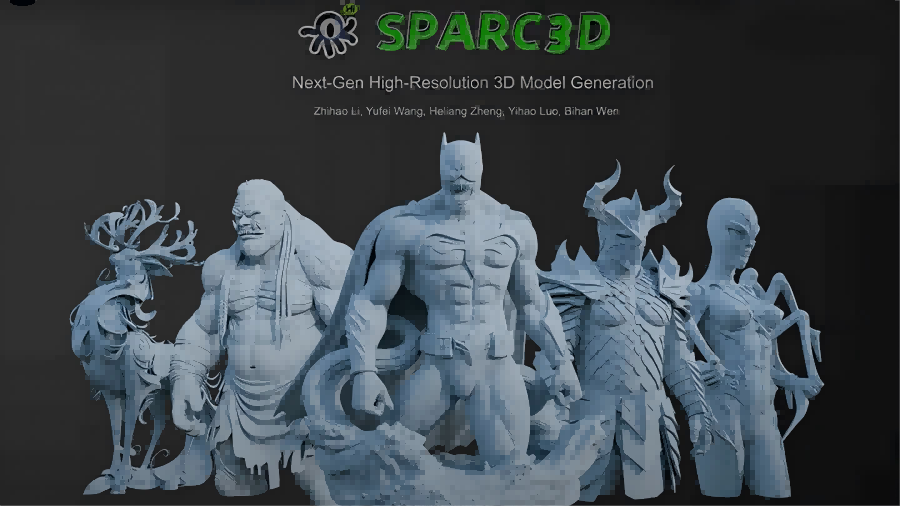Sparc3D – A 3D Model Generation Framework Developed by Nanyang Technological University and Other Institutions
What is Sparc3D?
Sparc3D is a high-resolution 3D model generation framework jointly developed by Nanyang Technological University, Sensory Universe, and Imperial College London. It addresses the limitations of traditional 3D generation methods, particularly detail loss and inefficiency. The framework combines Sparcubes (Sparse Deformable Marching Cubes representation) and Sparconv-VAE (Sparse Convolutional Variational Autoencoder).
Sparcubes enables rapid conversion of raw meshes into high-resolution (1024³) closed surfaces, preserving intricate details while reducing computational cost. Sparconv-VAE, based on sparse convolutional networks, performs efficient 3D reconstruction without relying on complex attention mechanisms. Sparc3D demonstrates strong performance in both reconstruction and generation tasks, handling complex geometries and open surfaces with significantly lower training and inference costs, offering a new solution for high-resolution 3D content creation.

Key Features of Sparc3D
-
High-Resolution 3D Reconstruction
Converts raw meshes into high-resolution (1024³) closed surfaces while maintaining geometric detail. -
Detail Preservation
Maintains fine geometric features, even when processing complex shapes, avoiding common detail loss. -
Efficient Training & Inference
Built on sparse convolutional networks, drastically reducing training and inference costs for faster generation. -
Compatibility
Seamlessly integrates with existing implicit diffusion models (e.g., TRELLIS) to enhance 3D object resolution. -
Handles Complex Inputs
Supports open surfaces, disconnected components, and intricate geometries to generate closed, printable 3D models.
Technical Foundations of Sparc3D
Sparcubes (Sparse Deformable Marching Cubes)
-
Extracts sparse activated voxels from input meshes, sampling only near-surface voxels to cut down computation and storage.
-
Uses a flood-fill algorithm to assign rough inside/outside labels to voxels, then refines the Signed Distance Function (SDF) via gradient optimization.
-
Applies gradient descent to optimize vertex positions of the voxel grid, aligning the mesh more accurately with the target surface.
-
Employs differentiable rendering and integrates multi-view images, silhouettes, or depth maps to further refine geometry.
Sparconv-VAE (Sparse Convolutional Variational Autoencoder)
-
Encodes Sparcubes parameters (sign distances and deformation vectors) into sparse latent features.
-
During decoding, dynamically adjusts voxel resolution using a self-pruning mechanism to restore fine geometry.
-
Performs encoding and decoding directly on sparse voxel representations, avoiding modality conversion from surface points to SDF, reducing information loss.
-
Minimizes losses related to occupancy, sign, scale, deformation, and KL divergence, enabling efficient training and high-fidelity reconstruction.
Project Links
-
Official Website: https://lizhihao6.github.io/Sparc3D/
-
GitHub Repository: https://github.com/lizhihao6/Sparc3D
-
arXiv Paper: https://arxiv.org/pdf/2505.14521
-
Online Demo: https://huggingface.co/spaces/ilcve21/Sparc3D
Application Scenarios
-
Virtual Reality (VR) and Augmented Reality (AR):
Quickly generate high-resolution 3D models to create realistic virtual environments and enhance immersion. -
3D Printing:
Produces closed, high-resolution 3D models ready for direct use in 3D printing, ensuring accuracy and completeness. -
Game Development:
Enables fast generation of high-res game environments and characters, optimizing real-time rendering while saving time and cost. -
Robotic Simulation:
Supplies high-precision 3D environmental models to support robot simulation and efficient path planning in complex scenes. -
Film VFX and Animation Production:
Facilitates rapid creation of high-resolution 3D characters and scenes, enhancing the visual quality of VFX and animations.
Related Posts




